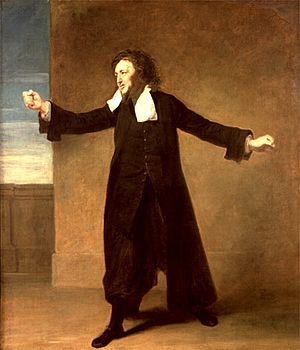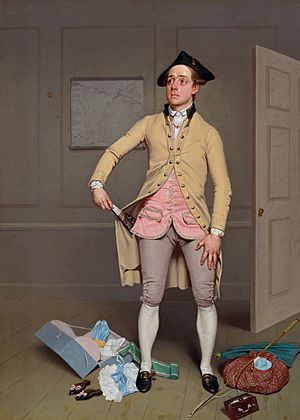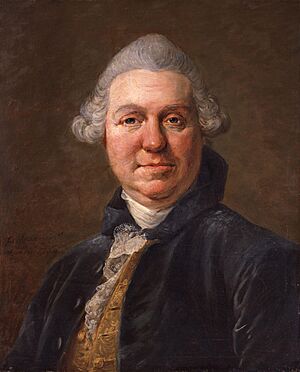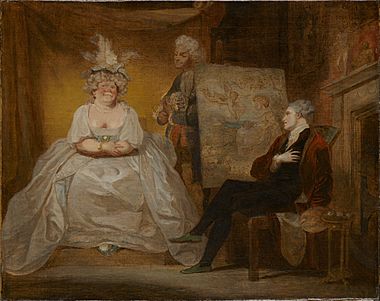Samuel Foote facts for kids
Samuel Foote (born January 1720 – died 21 October 1777) was a British playwright, actor, and theatre manager. He was well-known for his funny acting and writing. He even used the loss of his leg in a riding accident in 1766 to make people laugh in his shows!
Contents
Early Life and Education
Samuel Foote was born into a wealthy family in Truro, Cornwall, in January 1720. His father, also named Samuel Foote, held important public jobs, like being the mayor of Truro and a Member of Parliament. His mother, Eleanor Goodere, came from a family known for being quite unique. Samuel might have gotten his sharp wit and humor from her side of the family.
Around the time he became an adult, Samuel inherited a large sum of money from one of his uncles. He even wrote his first pamphlet (a small book) about a sad family event around 1741.
Samuel went to Truro Grammar School and Worcester College, Oxford. He was known for being a great mimic (someone who can copy others) and for his funny jokes. However, he wasn't the best student and often missed his Latin and Greek classes. Because of this, Oxford University asked him to leave in 1740. Even though he didn't get a degree, he learned a lot about classic stories and languages. This helped him use old quotes and ideas in his writing and made his words flow nicely.
Samuel was supposed to study law, but he wasn't really interested. He spent a lot of time in coffee houses near his law chambers, learning about lawyers and their ways. This later helped him make fun of legal talk and the habits of lawyers in his plays. He spent his money quickly and lived a fancy life, which soon led to him running out of funds.
After getting into debt, Samuel married Mary Hickes in 1741. She brought a good amount of money with her. However, Samuel soon left her when his money problems got better. He was more interested in the exciting world of theatre, especially at the Bedford Coffee-house in Covent Garden. His expensive lifestyle eventually landed him in debtor's prison in 1742. His friends then suggested he try acting to earn a living.
First Steps in Theatre

Samuel Foote learned to act from Charles Macklin, a very famous actor. By 1744, Macklin was one of the top actors in Britain, right after David Garrick. Macklin's performance as Shylock in Shakespeare's The Merchant of Venice in 1741 amazed audiences in London. He played Shylock as a truly evil character, which was different from how others had played him.
After less than a year of training, Foote acted opposite Macklin in Shakespeare's Othello at the Haymarket Theatre in 1744. His first performance wasn't a big hit. This play was actually put on illegally because of a law called the Licensing Act 1737. To get around this law, the Haymarket Theatre would hold music concerts and then offer the plays for free.
After his first try in London, Foote went to Dublin for the summer season and found his first success there. When he came back to England, he joined the company at the Theatre Royal, Drury Lane. Here, he played funny roles, like Harry Wildair in The Constant Couple and Lord Foppington in The Relapse. Most notably, he played the playwright Bayes in The Rehearsal. In this role, Foote really showed off his talent for copying people. He used this part to make fun of many leading figures of his time.
Running His Own Theatre
Even with his acting success, Foote was still poor. He decided to try managing a theatre and got a lease for the Haymarket Theatre in 1746. Foote started writing seriously, creating two pamphlets.
He then put on one of his own plays, The Diversions of the Morning or, A Dish of Chocolate, in 1747. This play made fun of actors and public figures of the time, and Foote performed in it himself. To avoid the Licensing Act, Foote offered a "dish of chocolate" or tea with musical entertainment, and the play itself was "free." The day after the first show, authorities locked the theatre, turning away audiences who came for the noon performance (another trick to avoid the law was to call it a morning show). Foote's jokes about other actors made the managers of Drury Lane Theatre angry, and they tried to stop him.
Luckily for Foote, some powerful friends at court helped the theatre reopen, and the play continued. In June, Foote offered A Cup of Tea, which was a new version of his show Diversions. After a short trip to Paris, Foote opened The Auction of Pictures, which made fun of the writer Henry Fielding. They started a "war of wit," making fun of each other in writing and on stage.
The Author and Other Plays
After his disagreement with Fielding, Foote had a more serious argument with actor Henry Woodward. This caused a small riot that hurt both the Haymarket Theatre and Foote's reputation. He only started to get rid of the criticism when he opened his play, The Knights. This play was a romantic comedy set in the countryside, different from his earlier funny shows. However, he still used it to make fun of things like Italian opera and the wealthy people of Cornwall.
At the end of the Haymarket season in 1749, Foote left London for Paris to spend some money he had just inherited. When he returned to London in 1752, his new comedy, Taste, was performed at Drury Lane. In this play, Foote aimed his jokes at the growing market for art and old objects, especially wealthy collectors.
Taste shows funny characters like Lady Pentweazel, who thinks famous statues are sisters. Two other collectors, Novice and Lord Dupe, claim they can tell the age of coins by tasting them! An auctioneer named Puff convinces them that broken art is worth more than perfect pieces. Lord Dupe even buys a painting with the paint scraped off. Foote used this play to show how silly some ignorant art collectors and tricky dealers could be. The audience at the first show didn't quite understand the humor, so the play only ran for five performances.
After Taste wasn't very successful, Foote put on a new play called An Englishman in Paris. This play was inspired by his trip to Paris and possibly a French play he had seen. In it, Foote made fun of how rude English gentlemen could be when traveling abroad. The play was a big hit and was performed for many years at Drury Lane and Covent Garden. As his writing became more popular, Foote was also in demand as an actor.
In 1754, Foote rented the Haymarket theatre again and started putting on fake lectures. He was making fun of Charles Macklin's new speaking school. This led to a kind of theatre "war," especially when Macklin himself started showing up at the lectures. At one lecture, Foote made up some silly words to test Macklin's claim that he could remember any text after hearing it once. This led to the famous nonsense phrase "The Grand Panjandrum" becoming part of the English language.
Another playwright, Arthur Murphy, was inspired by Foote's An Englishman in Paris and decided to write a sequel called The Englishman returned from Paris. Foote encouraged Murphy's idea, but secretly wrote his own version, which opened in 1756. While some people thought Foote copied Murphy, it was later shown that Foote's play was much better. It was very successful and played regularly until 1760.
Two rival actresses, Peg Woffington and George Anne Bellamy, were very popular. They took their roles seriously in a play called The Rival Queens. When Bellamy's fancy Parisian clothes started to outshine Woffington, Woffington supposedly chased Bellamy off stage with a dagger! This event inspired Foote's lost play, The Green-Room Squabble or a Battle Royal between the Queen of Babylon and the Daughter of Darius.
After making fun of Englishmen abroad and actresses at home, Foote turned his humor on himself, other writers, and the struggles of "starving writers" in his play The Author. It opened in 1757. The story was about a poor writer whose father disguises himself to spy on his son. Foote played the role of Cadwallader and used it to make fun of John Apreece, a rich supporter of writers. Critics didn't like Foote's attack on Apreece, but audiences loved it. Apreece himself even came to watch and sat "open-mouthed and silly" in the audience, confused by seeing himself on stage. Foote later said that Apreece found the joke "too strong" and "too funny," which led to the play being stopped by the Lord Chamberlain. Even though its success was limited, Richard Brinsley Sheridan used parts of its story in his famous play School for Scandal. Today, critics say The Author showed how much Foote had grown in creating characters and good stories.
Mimicry and The Minor

In late 1757, Foote met a young actor and mimic named Tate Wilkinson. Wilkinson was also known for his funny imitations of others. Foote traveled with him to Dublin, and he even brought back his old show Diversions of the Morning to show off Wilkinson's talents. Wilkinson's popularity was so great that it filled the Drury Lane theatre, much to the annoyance of David Garrick and other actors. However, this popularity didn't last, and by March, Foote was looking for work elsewhere.
With little luck in London, Foote went to Edinburgh and found success with many of his plays, including The Author, which couldn't be performed in London. The next season, Foote was in Dublin, where Wilkinson was still drawing crowds with his imitations. In 1760, Foote opened a new play called The Minor, but it was not successful.
Returning to London, Foote was still struggling financially. He rented the Haymarket theatre and changed The Minor into a longer, three-act play. When it opened in London, it was a huge hit! Even though it had failed in Dublin because some found it too rude, English society filled the theatres for 38 nights.
The Minor used a simple story to make fun of the Methodist movement. Before the play opened, Foote showed the text to the Archbishop of Canterbury, Thomas Secker. The Archbishop didn't like some parts, especially a character calling herself a "lost sheep," saying that phrase was sacred. Foote asked the Archbishop to remove the parts he didn't like, and the Archbishop agreed, but only if the play was published as "Revised and Corrected by the Archbishop of Canterbury."
Later Life and Works
While riding with Prince Edward, Duke of York and Albany in 1766, Samuel Foote was thrown from his horse and lost his leg. Even after this injury, he continued to act. As a way to make up for his injury, he was given a special license to legally run the Haymarket Theatre. He put on a summer season of plays in 1767 and even bought and remodeled the theatre that same year. He continued to manage it until he had to give it up to George Colman the Elder the next year. Foote lived and wrote in his beloved home, 'The Hermitage', in North End village. He passed away on 21 October 1777 in Dover, while traveling to France.
One of his plays, The Cozeners, was clearly based on the politician Charles James Fox, who was known for spending too much and gambling. Fox had been tricked by a woman who promised he could marry a rich heiress. This woman was tried and sent away in 1773. The next year, The Cozeners opened with an actress playing a character similar to her. Foote's plays often used funny versions of real people and situations from his time. His skill and humor in writing earned him the nickname "the English Aristophanes" (a famous ancient Greek comedian). While his subjects often found his jokes as funny as his audiences did, they also both feared and admired him.
Samuel Foote in Books
Samuel Foote is mentioned in the 1844 novel The Luck of Barry Lyndon by William Makepeace Thackeray, where the main character says Foote is his friend. Foote is also mentioned in The Boswell Brothers by Philip Baruth.
Dramatic Works
| Title | Year First Performed | Where it First Played | Year Published |
|---|---|---|---|
| The Diversions of the Morning or, A Dish of Chocolate (later called A Cup of Tea) | 1747 | Haymarket | ---- |
| An Auction of Pictures | 1748 | Haymarket | ---- |
| The Knights | 1748 | Drury Lane | 1754 |
| Taste | 1752 | Drury Lane | 1752 |
| An Englishman in Paris | 1753 | Covent Garden | 1753 |
| A Writ of Inquiry on the Inquisitor General | 1754 | Haymarket | ---- |
| The Englishman Returned from Paris | 1756 | Covent Garden | 1756 |
| The Green-Room Squabble or a Battle Royal between the Queen of Babylon and the Daughter of Darius | 1756 | Haymarket | Lost |
| The Author | 1757 | Drury Lane | 1757 |
| The Minor | 1760 | Haymarket | 1760 |
| Tragedy a la Mode (a different Act 2 for Diversions) | 1760 | Drury Lane | 1795 |
| The Lyar | 1762 | Covent Garden | 1764 |
| The Orators | 1762 | Haymarket | 1762 |
| The Mayor of Garratt | 1763 | Haymarket | 1764 |
| The Trial of Samuel Foote, Esq. for a Libel on Peter Paragraph | 1763 | Haymarket | 1795 |
| The Patron | 1764 | Haymarket | 1764 |
| The Commissary | 1765 | Haymarket | 1765 |
| The Devil on Two Sticks | 1768 | Haymarket | 1778 |
| The Lame Lover | 1770 | Haymarket | 1771 |
| The Maid of Bath | 1771 | Haymarket | 1771 |
| The Nabob | 1772 | Haymarket | 1778 |
| Piety in Pattens | 1773 | Haymarket | 1973 |
| The Bankrupt | 1773 | Haymarket | 1776 |
| The Cozeners | 1774 | Haymarket | 1776 |
| A Trip to Calais (later called The Capuchin) | 1776 | Haymarket | 1778 |
Books About Samuel Foote
- Cooke, William. Memoirs of Samuel Foote, Esq: With a Collection of His Genuine Bon-mots, Anecdotes, Opinions, &c 1805. (Online.)
- Foote, Samuel. The Dramatic Works of Samuel Foote, Esq.; to which is prefaced A Life of the Author. London, 1809. Reprinted by Benjamin Bloom, Bronx, New York.
- Kelly, Ian. Mr Foote's Other Leg: Comedy, tragedy and murder in Georgian London, 2012. Picador; later adapted as a play under the same title



